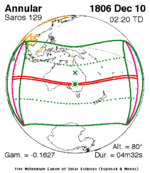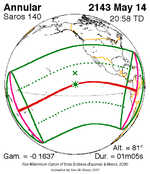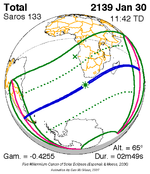Solar eclipse of April 20, 2023
| Solar eclipse of April 20, 2023 | |
|---|---|
 Partial from Magetan, Indonesia | |
| Type of eclipse | |
| Nature | Hybrid |
| Gamma | −0.3952 |
| Magnitude | 1.0132 |
| Maximum eclipse | |
| Duration | 76 s (1 min 16 s) |
| Coordinates | 9°36′S 125°48′E / 9.6°S 125.8°E |
| Max. width of band | 49 km (30 mi) |
| Times (UTC) | |
| Greatest eclipse | 4:17:56 |
| References | |
| Saros | 129 (52 of 80) |
| Catalog # (SE5000) | 9559 |
A total solar eclipse occurred at the Moon’s ascending node of orbit on Thursday, April 20, 2023,[1] with a magnitude of 1.0132. It was a hybrid event, a narrow total eclipse, and beginning and ending as an annular eclipse. A solar eclipse occurs when the Moon passes between Earth and the Sun thereby totally or partly obscuring the Sun for a viewer on Earth. A hybrid solar eclipse is a rare type of solar eclipse that changes its appearance from annular to total and back as the Moon's shadow moves across the Earth's surface.[2] Totality occurs between the annularity paths across the surface of the Earth, with the partial solar eclipse visible over a surrounding region thousands of kilometres wide.[3] Hybrid solar eclipses are extremely rare, occurring in only 3.1% of solar eclipses in the 21st century.[4] Occurring about 4.1 days after perigee (on April 16, 2023, at 3:20 UTC), the Moon's apparent diameter was larger.[5][6]
Totality for this eclipse was visible in the North West Cape peninsula and Barrow Island in Western Australia, eastern parts of East Timor, as well as Damar Island and parts of the province of Papua in Indonesia.[7] A partial eclipse was visible for parts of Antarctica, Australia, Oceania, and Southeast Asia. More than 20,000 people watched the eclipse from the town of Exmouth on Western Australia's North West Cape.[8] Providing infrastructure and services for the visitors (Exmouth's normal population is less than 3,000) cost the State Government of Western Australia A$20 million (US$13.5 million). The date marked a significant moment of astrotourism and tourism in Western Australia.[9]
Images
[edit]Gallery
[edit]Australia
[edit]-
Video of totality from Exmouth, Western Australia
-
Partial from Perth, Western Australia, 03:19 UTC
East Timor
[edit]Indonesia
[edit]-
Partial from Jakarta, 03:47 UTC
-
Partial from Palangka Raya, Central Kalimantan, 04:02 UTC
-
Partial from Pangkal Pinang, Bangka Belitung Islands, 04:05 UTC
Malaysia
[edit]Philippines
[edit]-
Partial from San Fernando, Pampanga, 04:50 UTC
-
Partial from San Jose del Monte, Bulacan, 04:55 UTC
-
Partial from Novaliches, Quezon City, 04:49 UTC
Vietnam
[edit]-
Partial from Ho Chi Minh City, 04:21 UTC
Eclipse details
[edit]Shown below are two tables displaying details about this particular solar eclipse. The first table outlines times at which the moon's penumbra or umbra attains the specific parameter, and the second table describes various other parameters pertaining to this eclipse.[10]
| Event | Time (UTC) |
|---|---|
| First Penumbral External Contact | 2023 April 20 at 01:35:34.3 UTC |
| First Umbral External Contact | 2023 April 20 at 02:38:15.0 UTC |
| First Central Line | 2023 April 20 at 02:38:18.4 UTC |
| First Umbral Internal Contact | 2023 April 20 at 02:38:21.7 UTC |
| First Penumbral Internal Contact | 2023 April 20 at 03:54:32.2 UTC |
| Equatorial Conjunction | 2023 April 20 at 03:56:44.7 UTC |
| Ecliptic Conjunction | 2023 April 20 at 04:13:41.1 UTC |
| Greatest Duration | 2023 April 20 at 04:17:26.8 UTC |
| Greatest Eclipse | 2023 April 20 at 04:17:56.0 UTC |
| Last Penumbral Internal Contact | 2023 April 20 at 04:41:47.9 UTC |
| Last Umbral Internal Contact | 2023 April 20 at 05:57:41.3 UTC |
| Last Central Line | 2023 April 20 at 05:57:47.4 UTC |
| Last Umbral External Contact | 2023 April 20 at 05:57:53.5 UTC |
| Last Penumbral External Contact | 2023 April 20 at 07:00:31.9 UTC |
| Parameter | Value |
|---|---|
| Eclipse Magnitude | 1.01320 |
| Eclipse Obscuration | 1.02657 |
| Gamma | −0.39515 |
| Sun Right Ascension | 01h51m01.7s |
| Sun Declination | +11°24'54.1" |
| Sun Semi-Diameter | 15'55.4" |
| Sun Equatorial Horizontal Parallax | 08.8" |
| Moon Right Ascension | 01h51m43.2s |
| Moon Declination | +11°04'16.7" |
| Moon Semi-Diameter | 15'53.6" |
| Moon Equatorial Horizontal Parallax | 0°58'19.9" |
| ΔT | 71.1 s |
Eclipse season
[edit]This eclipse is part of an eclipse season, a period, roughly every six months, when eclipses occur. Only two (or occasionally three) eclipse seasons occur each year, and each season lasts about 35 days and repeats just short of six months (173 days) later; thus two full eclipse seasons always occur each year. Either two or three eclipses happen each eclipse season. In the sequence below, each eclipse is separated by a fortnight.
| April 20 Ascending node (new moon) |
May 5 Descending node (full moon) |
|---|---|
 |

|
| Hybrid solar eclipse Solar Saros 129 |
Penumbral lunar eclipse Lunar Saros 141 |
Related eclipses
[edit]Eclipses in 2023
[edit]- A hybrid solar eclipse on April 20.
- A penumbral lunar eclipse on May 5.
- An annular solar eclipse on October 14.
- A partial lunar eclipse on October 28.
Metonic
[edit]- Preceded by: Solar eclipse of July 2, 2019
- Followed by: Solar eclipse of February 6, 2027
Tzolkinex
[edit]- Preceded by: Solar eclipse of March 9, 2016
- Followed by: Solar eclipse of June 1, 2030
Half-Saros
[edit]- Preceded by: Lunar eclipse of April 15, 2014
- Followed by: Lunar eclipse of April 25, 2032
Tritos
[edit]- Preceded by: Solar eclipse of May 20–21, 2012
- Followed by: Solar eclipse of March 20, 2034
Solar Saros 129
[edit]- Preceded by: Solar eclipse of April 8, 2005
- Followed by: Solar eclipse of April 30, 2041
Inex
[edit]- Preceded by: Solar eclipse of May 10, 1994
- Followed by: Solar eclipse of March 30, 2052
Triad
[edit]- Preceded by: Solar eclipse of June 19, 1936
- Followed by: Solar eclipse of February 18, 2110
Solar eclipses of 2022–2025
[edit]This eclipse is a member of a semester series. An eclipse in a semester series of solar eclipses repeats approximately every 177 days and 4 hours (a semester) at alternating nodes of the Moon's orbit.[11]
| Solar eclipse series sets from 2022 to 2025 | ||||||
|---|---|---|---|---|---|---|
| Ascending node | Descending node | |||||
| Saros | Map | Gamma | Saros | Map | Gamma | |
119 Partial in CTIO, Chile |
April 30, 2022 Partial |
−1.19008 | 124 Partial from Saratov, Russia |
October 25, 2022 Partial |
1.07014 | |
129 Partial in Magetan, Indonesia |
April 20, 2023 Hybrid |
−0.39515 | 134 Annularity in Hobbs, NM, USA |
October 14, 2023 Annular |
0.37534 | |
139 Totality in Dallas, TX, USA |
April 8, 2024 Total |
0.34314 | 144 Annularity in Santa Cruz Province, Argentina |
October 2, 2024 Annular |
−0.35087 | |
| 149 | March 29, 2025 Partial |
1.04053 | 154 | September 21, 2025 Partial |
−1.06509 | |
Saros 129
[edit]This eclipse is a part of Saros series 129, repeating every 18 years, 11 days, and containing 80 events. The series started with a partial solar eclipse on October 3, 1103. It contains annular eclipses from May 6, 1464 through March 18, 1969; hybrid eclipses from March 29, 1987 through April 20, 2023; and total eclipses from April 30, 2041 through July 26, 2185. The series ends at member 80 as a partial eclipse on February 21, 2528. Its eclipses are tabulated in three columns; every third eclipse in the same column is one exeligmos apart, so they all cast shadows over approximately the same parts of the Earth.
The longest duration of annularity was produced by member 34 at 5 minutes, 10 seconds on October 4, 1698, and the longest duration of totality will be produced by member 58 at 3 minutes, 43 seconds on June 25, 2131. All eclipses in this series occur at the Moon’s ascending node of orbit.[12]
| Series members 40–61 occur between 1801 and 2200: | ||
|---|---|---|
| 40 | 41 | 42 |
 December 10, 1806 |
 December 20, 1824 |
 December 31, 1842 |
| 43 | 44 | 45 |
 January 11, 1861 |
 January 22, 1879 |
 February 1, 1897 |
| 46 | 47 | 48 |
 February 14, 1915 |
 February 24, 1933 |
 March 7, 1951 |
| 49 | 50 | 51 |
 March 18, 1969 |
 March 29, 1987 |
 April 8, 2005 |
| 52 | 53 | 54 |
 April 20, 2023 |
 April 30, 2041 |
 May 11, 2059 |
| 55 | 56 | 57 |
 May 22, 2077 |
 June 2, 2095 |
 June 13, 2113 |
| 58 | 59 | 60 |
 June 25, 2131 |
 July 5, 2149 |
 July 16, 2167 |
| 61 | ||
 July 26, 2185 | ||
Metonic series
[edit]The metonic series repeats eclipses every 19 years (6939.69 days), lasting about 5 cycles. Eclipses occur in nearly the same calendar date. In addition, the octon subseries repeats 1/5 of that or every 3.8 years (1387.94 days). All eclipses in this table occur at the Moon's ascending node.
| 21 eclipse events between July 1, 2000 and July 1, 2076 | ||||
|---|---|---|---|---|
| July 1–2 | April 19–20 | February 5–7 | November 24–25 | September 12–13 |
| 117 | 119 | 121 | 123 | 125 |
 July 1, 2000 |
 April 19, 2004 |
 February 7, 2008 |
 November 25, 2011 |
 September 13, 2015 |
| 127 | 129 | 131 | 133 | 135 |
 July 2, 2019 |
 April 20, 2023 |
 February 6, 2027 |
 November 25, 2030 |
 September 12, 2034 |
| 137 | 139 | 141 | 143 | 145 |
 July 2, 2038 |
 April 20, 2042 |
 February 5, 2046 |
 November 25, 2049 |
 September 12, 2053 |
| 147 | 149 | 151 | 153 | 155 |
 July 1, 2057 |
 April 20, 2061 |
 February 5, 2065 |
 November 24, 2068 |
 September 12, 2072 |
| 157 | ||||
 July 1, 2076 | ||||
Tritos series
[edit]This eclipse is a part of a tritos cycle, repeating at alternating nodes every 135 synodic months (≈ 3986.63 days, or 11 years minus 1 month). Their appearance and longitude are irregular due to a lack of synchronization with the anomalistic month (period of perigee), but groupings of 3 tritos cycles (≈ 33 years minus 3 months) come close (≈ 434.044 anomalistic months), so eclipses are similar in these groupings.
| Series members between 1801 and 2200 | ||||
|---|---|---|---|---|
 January 1, 1805 (Saros 109) |
 October 31, 1826 (Saros 111) |
 August 28, 1848 (Saros 113) | ||
 July 29, 1859 (Saros 114) |
 June 28, 1870 (Saros 115) |
 May 27, 1881 (Saros 116) |
 April 26, 1892 (Saros 117) |
 March 29, 1903 (Saros 118) |
 February 25, 1914 (Saros 119) |
 January 24, 1925 (Saros 120) |
 December 25, 1935 (Saros 121) |
 November 23, 1946 (Saros 122) |
 October 23, 1957 (Saros 123) |
 September 22, 1968 (Saros 124) |
 August 22, 1979 (Saros 125) |
 July 22, 1990 (Saros 126) |
 June 21, 2001 (Saros 127) |
 May 20, 2012 (Saros 128) |
 April 20, 2023 (Saros 129) |
 March 20, 2034 (Saros 130) |
 February 16, 2045 (Saros 131) |
 January 16, 2056 (Saros 132) |
 December 17, 2066 (Saros 133) |
 November 15, 2077 (Saros 134) |
 October 14, 2088 (Saros 135) |
 September 14, 2099 (Saros 136) |
 August 15, 2110 (Saros 137) |
 July 14, 2121 (Saros 138) |
 June 13, 2132 (Saros 139) |
 May 14, 2143 (Saros 140) |
 April 12, 2154 (Saros 141) |
 March 12, 2165 (Saros 142) |
 February 10, 2176 (Saros 143) |
 January 9, 2187 (Saros 144) |
 December 9, 2197 (Saros 145) | |||
Inex series
[edit]This eclipse is a part of the long period inex cycle, repeating at alternating nodes, every 358 synodic months (≈ 10,571.95 days, or 29 years minus 20 days). Their appearance and longitude are irregular due to a lack of synchronization with the anomalistic month (period of perigee). However, groupings of 3 inex cycles (≈ 87 years minus 2 months) comes close (≈ 1,151.02 anomalistic months), so eclipses are similar in these groupings.
| Series members between 1801 and 2200 | ||
|---|---|---|
 September 7, 1820 (Saros 122) |
 August 18, 1849 (Saros 123) |
 July 29, 1878 (Saros 124) |
 July 10, 1907 (Saros 125) |
 June 19, 1936 (Saros 126) |
 May 30, 1965 (Saros 127) |
 May 10, 1994 (Saros 128) |
 April 20, 2023 (Saros 129) |
 March 30, 2052 (Saros 130) |
 March 10, 2081 (Saros 131) |
 February 18, 2110 (Saros 132) |
 January 30, 2139 (Saros 133) |
 January 10, 2168 (Saros 134) |
 December 19, 2196 (Saros 135) |
|
References
[edit]- ^ "April 20, 2023 Total Solar Eclipse". timeanddate. Retrieved 13 August 2024.
- ^ "Lunar eclipse 2023: The rare celestial event which will not happen again till 2042". India Today (Press release). Retrieved 27 April 2023.
- ^ "How to view this week's rare hybrid eclipse". CNN. Retrieved 27 April 2023.
- ^ "Hybrid solar eclipse: Everything you need to know about the rare and strange phenomenon". Space.com. 20 November 2022. Archived from the original on 9 January 2023. Retrieved 9 January 2023.
- ^ "Moon Distances for London, United Kingdom, England". timeanddate. Retrieved 13 August 2024.
- ^ "Solar Eclipse 2023 Date, Time First Solar Eclipse of 2023". gotopnews.com. 20 April 2023. Archived from the original on 20 April 2023.
- ^ Hybrid Solar Eclipse of 2023 Apr 20 Archived 2021-01-17 at the Wayback Machine, National Aeronautics and Space Administration
- ^ "Solar eclipse chasers descend on tiny Western Australian town to experience 'wonders of the universe'". The Guardian. 20 April 2023. Archived from the original on 20 April 2023.
- ^ Marcus, Lilit (19 April 2023). "How a solar eclipse could change this small Australian town forever". CNN. Archived from the original on 21 April 2023. Retrieved 20 April 2023.
- ^ "Hybrid Solar Eclipse of 2023 Apr 20". EclipseWise.com. Retrieved 13 August 2024.
- ^ van Gent, R.H. "Solar- and Lunar-Eclipse Predictions from Antiquity to the Present". A Catalogue of Eclipse Cycles. Utrecht University. Retrieved 6 October 2018.
- ^ "NASA - Catalog of Solar Eclipses of Saros 129". eclipse.gsfc.nasa.gov.
External links
[edit]- Earth visibility chart and eclipse statistics Eclipse Predictions by Fred Espenak, NASA/GSFC



















